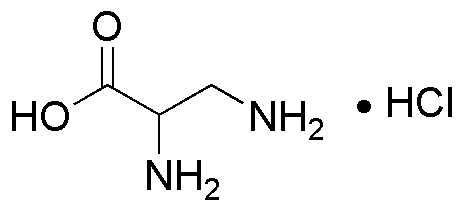DL-2,3-Diaminopropionic acid monohydrochloride is widely utilized in research focused on:
- Pharmaceutical Development: This compound serves as a key building block in the synthesis of various pharmaceuticals, particularly in the development of drugs targeting neurological disorders.
- Biochemical Research: It is employed in studies related to amino acid metabolism, helping researchers understand metabolic pathways and enzyme functions.
- Protein Engineering: The compound is used in the modification of proteins, enhancing their stability and activity, which is crucial for biotechnological applications.
- Food Industry: It can be utilized as a food additive to enhance nutritional profiles, particularly in protein-rich products, offering benefits over traditional amino acids.
- Cosmetic Formulations: This chemical is incorporated into skincare products for its moisturizing properties, providing an advantage in formulations aimed at improving skin hydration.
General Information
Properties
Safety and Regulations
Applications
DL-2,3-Diaminopropionic acid monohydrochloride is widely utilized in research focused on:
- Pharmaceutical Development: This compound serves as a key building block in the synthesis of various pharmaceuticals, particularly in the development of drugs targeting neurological disorders.
- Biochemical Research: It is employed in studies related to amino acid metabolism, helping researchers understand metabolic pathways and enzyme functions.
- Protein Engineering: The compound is used in the modification of proteins, enhancing their stability and activity, which is crucial for biotechnological applications.
- Food Industry: It can be utilized as a food additive to enhance nutritional profiles, particularly in protein-rich products, offering benefits over traditional amino acids.
- Cosmetic Formulations: This chemical is incorporated into skincare products for its moisturizing properties, providing an advantage in formulations aimed at improving skin hydration.
Documents
Safety Data Sheets (SDS)
The SDS provides comprehensive safety information on handling, storage, and disposal of the product.
Product Specification (PS)
The PS provides a comprehensive breakdown of the product’s properties, including chemical composition, physical state, purity, and storage requirements. It also details acceptable quality ranges and the product's intended applications.
Certificates of Analysis (COA)
Search for Certificates of Analysis (COA) by entering the products Lot Number. Lot and Batch Numbers can be found on a product’s label following the words ‘Lot’ or ‘Batch’.
*Catalog Number
*Lot Number
Certificates Of Origin (COO)
This COO confirms the country where the product was manufactured, and also details the materials and components used in it and whether it is derived from natural, synthetic, or other specific sources. This certificate may be required for customs, trade, and regulatory compliance.
*Catalog Number
*Lot Number
Safety Data Sheets (SDS)
The SDS provides comprehensive safety information on handling, storage, and disposal of the product.
DownloadProduct Specification (PS)
The PS provides a comprehensive breakdown of the product’s properties, including chemical composition, physical state, purity, and storage requirements. It also details acceptable quality ranges and the product's intended applications.
DownloadCertificates of Analysis (COA)
Search for Certificates of Analysis (COA) by entering the products Lot Number. Lot and Batch Numbers can be found on a product’s label following the words ‘Lot’ or ‘Batch’.
*Catalog Number
*Lot Number
Certificates Of Origin (COO)
This COO confirms the country where the product was manufactured, and also details the materials and components used in it and whether it is derived from natural, synthetic, or other specific sources. This certificate may be required for customs, trade, and regulatory compliance.


